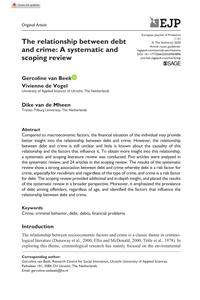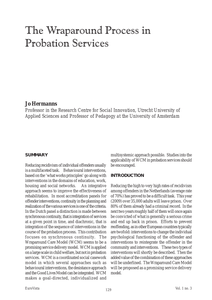Although studies point to a relationship between debt and crime, there is a limited understanding of their reciprocal relationship and possible mediating risk factors. Moreover, knowledge about the prevalence and scope of debt among offenders is lacking. Therefore, the present study analyzed 250 client files including risk assessment data from the Dutch probation service on the prevalence of debt and possibly related risk factors. The results show that debt is highly prevalent and complex, which underlines the importance of acquiring more knowledge about debt as a potential risk factor for relapse during supervision. It was found that problems with regard to childhood and living situation, education and work/daytime activities, and mental and physical health may be possible underlying risk factors in the relationship between debt and crime. These insights can help professionals adequately support clients with regard to debt in order to prevent recidivism. debt and crime. These insights can help professionals adequately support clients with regard to debt in order to prevent recidivism.
MULTIFILE

Compared to macroeconomic factors, the financial situation of the individual may provide better insight into the relationship between debt and crime. However, the relationship between debt and crime is still unclear and little is known about the causality of this relationship and the factors that influence it. To obtain more insight into this relationship, a systematic and scoping literature review was conducted. Five articles were analyzed in the systematic review, and 24 articles in the scoping review. The results of the systematic review show a strong association between debt and crime whereby debt is a risk factor for crime, especially for recidivism and regardless of the type of crime, and crime is a risk factor for debt. The scoping review provided additional and in-depth insight, and placed the results of the systematic review in a broader perspective. Moreover, it emphasized the prevalence of debt among offenders, regardless of age, and identified the factors that influence the relationship between debt and crime.
DOCUMENT

The number of applications for debt management services in the Netherlands shows a steady increase of about 10 percent each year, over the last few years. Municipalities, responsible for these services, at the same need to cut back on expenditures. Our research shows that the (social) return on debt management is on average twice as high as the costs. These benefits are mainly found in the areas of social welfare and housing. Since debts are a reason for employers not to hire or not to continue employment, debt management increases the chance of (continued) employment and therefore helps reduce costs of unemployment and welfare benefits. Since housing corporations spend large sums of money on evictions, the prevention of evictions through debt management also reduces costs in that area. The ratio between the costs and benefits is only partly influenced by the quality of execution. Social structure offers a better explanation, where a weaker social structure results in greater benefits. Our findings are based on extensive research of individual files combined with interviews with professionals. Only direct if-then relations were considered. This means that in reality the cost-benefit ratio may even be more favorable. Municipalities should therefore be careful in cutting back on debt management services. On the other hand, crosslinking debt management with welfare payments and co-operating with housing corporations could open up opportunities for co-financing debt management services.
DOCUMENT

Although studies point to a relationship between debt and crime, there is a limited understanding of their reciprocal relationship and possible mediating risk factors. Moreover, knowledge about the prevalence and scope of debt among offenders is lacking. Therefore, the present study analyzed 250 client files including risk assessment data from the Dutch probation service on the prevalence of debt and possibly related risk factors. The results show that debt is highly prevalent and complex, which underlines the importance of acquiring more knowledge about debt as a potential risk factor for relapse during supervision. It was found that problems with regard to childhood and living situation, education and work/daytime activities, and mental and physical health may be possible underlying risk factors in the relationship between debt and crime. These insights can help professionals adequately support clients with regard to debt in order to prevent recidivism
MULTIFILE

Little research exists on what works in the supervision of offenders with debt problems. This qualitative study aims to provide insight into the barriers probation officers and clients experience during supervision regarding debt and the support that clients need. Interviews were conducted with 33 Dutch probation officers and 16 clients. The results show that debt often negatively influences clients’ lives and hinders their resocialization. Probation officers lack effective methods to support clients with debt problems. To adequately help clients with debt problems, probation officers should obtain more knowledge about effective interventions and collaborate more closely with debt specialists from the probation supervision outset.
DOCUMENT

The relationship between socioeconomic factors and crime is a classic theme in criminological literature. However, the relationship between debt and crime is still unclear, and little is known about the causality of this relationship and the factors that influence it. In addition, effective interventions and guidelines to adequately support offenders with debt are limited. Therefore, this thesis aims to systematically gain more insight into the factors that influence the relationship between debt and crime among probation clients and to contribute to developing tools that probation officers and other forensic social professionals can use to support clients with debt adequately. The relationship between debt and crime was studied by (1) a systematic and scoping literature review (5 studies were included in the systematic review and 24 studies in the scoping review), (2) a client file study including risk assessment data of a sample of 250 Dutch probation clients, (3) a quantitative study including recidivism data of the same sample of 250 Dutch probation clients, (4) interviews with 33 Dutch probation officers and 16 clients, and (5) a multiple case study focusing on working elements in the supervision of individual offenders (5 cases). The results show that debt is prevalent among probation clients, hinders resocialization, and increases recidivism risk. Debt and crime are not only related directly but are also related by a complex interplay of problems in different life domains, such as problems regarding childhood, education and work, and mental and physical health. Notwithstanding the strong relationship between debt and crime, financial assistance for probation clients with debts is limited. As debt is strongly related to problems in other life domains, a systematic collaboration between professionals of different disciplines is necessary to support clients with debt adequately.
DOCUMENT

Reducing recidivism of individual offenders usually is a multifaceted task. Behavioural interventions, based on the ‘what works principles’ go along with interventions in the domains of education, work, housing and social networks. An integrative approach seems to improve the effectiveness of rehabilitation. In most accreditation panels for offender interventions, continuity in the planning and realization of the various services is one of the criteria. In the Dutch panel a distinction is made between synchronous continuity, that is integration of services at a given point in time, and diachronic, that is integration of the sequence of interventions in the course of the probation process. This contribution focuses on synchronous continuity.
DOCUMENT

Full text via link. In September 2015, a four year project on the working alliance with mandated clients started. The project was facilitated by a RAAK-PRO grant of the Dutch Organisation of Scientific Research (NWO) and carried out by researchers of the University of Applied Sciences Utrecht. The project has been set up throughout several areas of the forensic social field: probation, labor reintegration, debt counseling, social care and youth services. The idea came as a response to the ambivalent feelings professionals in mandated contexts express regarding the combination of controlling and coaching tasks they need to employ. They sometimes struggle with ‘hybrid working’ in one-to-one supervision with clients. Professionals claim they need theory-based knowledge on how to build a working alliance with mandated clients on which they can build their daily practice.
LINK
Schuldhulpverlening: Knelpunten en dilemma’s van coördinatoren die vrijwilligers aansturenDe afgelopen jaren is het aantal huishoudens in Nederland met schulden toegenomen. Ook de hoogte van de gemiddelde schuld nam toe. Gemeenten hebben te maken met een groeiende schuldenproblematiek in omvang, maar ook in complexiteit. Sinds 2012 zijn gemeenten verantwoordelijk voor de regievoering op schuldhulpverlening. Ook op het gebied van zorg en welzijn zijn de afgelopen jaren veranderingen opgetreden in gemeentelijk beleid. Met de komst van de Wet maatschappelijke ondersteuning (Wmo) in 2007 zijn gemeenten verantwoordelijk voor een integraal aanbod aan ondersteuning en zorg, waarbij de nadruk ligt op participatie en eigen verantwoordelijkheid. In de zorg, welzijn en schuldhulpverlening wordt meer ingezet op het betrekken van vrijwilligers. Van lokale organisaties die vrijwilligers inzetten en van de coördinatoren die deze vrijwilligers aansturen en begeleiden, wordt meer gevraagd op het gebied van werving en inzet van vrijwilligers op verschillende terreinen en voor verschillende doelgroepen.Thuisadministratieprojecten bieden ondersteuning door vrijwilligers aan mensen met administratieve en/of financiële problemen, met als doel toe te werken naar financiële zelfredzaamheid en/of het voorkomen van (grotere) financiële problemen. In dit artikel staat de onderzoeksvraag centraal: “Welke knelpunten en dilemma’s ervaren coördinatoren van Thuisadministratieprojecten, en in hoeverre komen die voort uit het huidige gemeentelijke beleid op het terrein van zorg, welzijn en integrale schuldhulpverlening?” Doel van het onderzoek was door inzicht te verkrijgen in problemen die coördinatoren ervaren en het leggen van de relatie met gemeentelijk beleid, aanbevelingen te kunnen doen om de dienstverlening, afstemming en samenwerking tussen gemeenten, beroepskrachten en vrijwilligers van lokale organisaties te verbeteren. De belangrijkste conclusie is dat coördinatoren naar afbakening van de grenzen van de ondersteuning zoeken: wat kan wel en niet worden gedaan door vrijwilligers en voor welke cliëntgroepen. In samenwerking en afstemming met de gemeente en beroepskrachten van andere organisaties moeten coördinatoren hierover afspraken maken.
DOCUMENT
